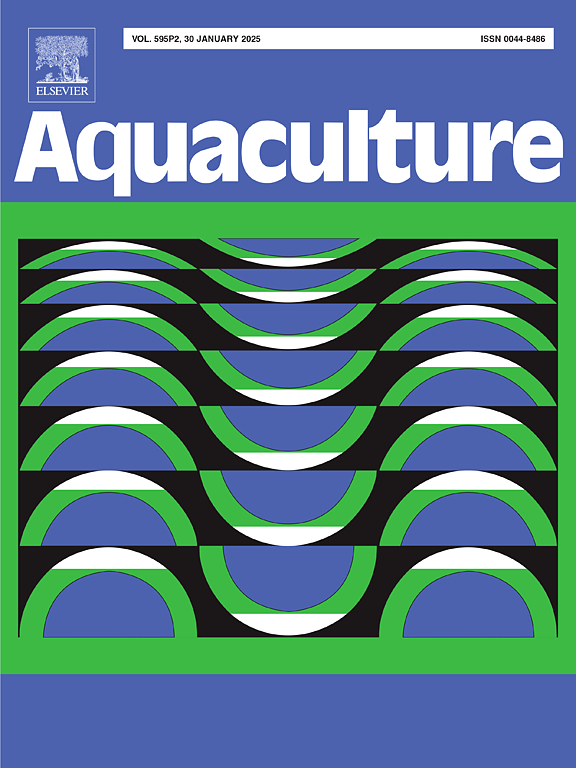泥蟹(Scylla paramamosain)对虹彩十足病毒1型感染的易感性
IF 3.9
1区 农林科学
Q1 FISHERIES
引用次数: 0
摘要
泥蟹是全球最重要的水产养殖品种之一。最近,十足类彩虹病毒1 (DIV1)因在甲壳类动物中引起大规模死亡事件而引起了极大的关注。流行病学调查显示,养殖泥蟹中DIV1的流行率较高。因此,了解泥蟹对DIV1的易感性对于提高农民的认识和减轻潜在疫情造成的经济损失至关重要。实验感染DIV1的螃蟹肌肉注射(IM组)死亡率为100%,口服(PO组)死亡率为60%。巢式PCR证实,两组的泥蟹均为DIV1阳性,且这些泥蟹的DIV1载量显著升高。组织病理学分析显示,在感染div1的泥蟹的肝胰腺、肌肉、鳃和胃组织中存在嗜酸性和嗜碱性包体,而透射电子显微镜(TEM)显示宿主细胞质中存在大量病毒颗粒。值得注意的是,除了表现出反应缓慢和食欲不振等症状外,一些受感染的螃蟹还表现出明显的身体发红,这可能是泥蟹感染DIV1的独特症状。致死剂量50 (LD50)试验表明,DIV1对泥蟹具有高毒力。还观察到DIV1在泥蟹的各种组织中广泛复制,造成严重的组织损伤。这些结果表明,泥蟹是DIV1的易感宿主,DIV1对泥蟹具有高致病性。此外,该研究强调了在混养系统中跨物种传播的风险,因为健康的凡纳滨对虾可以从受感染的泥蟹身上感染DIV1。这些结果强调了加强对泥蟹养殖中DIV1的监测和控制措施的必要性,以有效预防病毒的爆发。本文章由计算机程序翻译,如有差异,请以英文原文为准。
Susceptibility of mud crabs (Scylla paramamosain) to the infection with decapod iridescent virus 1
Mud crabs are among the most important aquaculture species globally. Recently, the decapod iridescent virus 1 (DIV1) has garnered significant attention for causing mass mortality events in crustaceans. The epidemiological investigation revealed a high prevalence of DIV1 in cultured mud crabs. Therefore, understanding the susceptibility of mud crabs to DIV1 is crucial for raising awareness among farmers and mitigating economic losses from potential outbreaks. Experimental infections with DIV1 showed 100 % mortality in intramuscularly injected (IM group) crabs and 60 % in those given oral administration (PO group). Nested PCR confirmed that mud crabs from both groups were positive for DIV1 and significantly elevated DIV1 loads in these mud crabs. Histopathological analyses revealed the presence of eosinophilic and basophilic inclusions in the hepatopancreas, muscle, gill, and stomach tissues of DIV1-infected mud crabs, while transmission electron microscopy (TEM) revealed numerous viral particles in the host cell cytoplasm. Notably, in addition to exhibiting symptoms like slow response and loss of appetite, some infected crabs exhibited distinctive body reddening, possibly a unique symptom of DIV1 infection in mud crab. The lethal dose 50 (LD50) test demonstrate that DIV1 is highly virulent to mud crabs. It was also observed that DIV1 replicated extensively in various tissues of mud crabs resulting in severe tissue damage. These findings demonstrate that mud crabs are susceptible hosts of DIV1, and DIV1 is highly pathogenic to them. Furthermore, the study highlights the risk of cross-species transmission in polyculture systems, as healthy Litopenaeus vannamei can contract DIV1 from infected mud crabs. These results emphasize the necessity for enhanced monitoring and control measures for DIV1 in mud crab farming to prevent viral outbreaks effectively.
求助全文
通过发布文献求助,成功后即可免费获取论文全文。
去求助
来源期刊

Aquaculture
农林科学-海洋与淡水生物学
CiteScore
8.60
自引率
17.80%
发文量
1246
审稿时长
56 days
期刊介绍:
Aquaculture is an international journal for the exploration, improvement and management of all freshwater and marine food resources. It publishes novel and innovative research of world-wide interest on farming of aquatic organisms, which includes finfish, mollusks, crustaceans and aquatic plants for human consumption. Research on ornamentals is not a focus of the Journal. Aquaculture only publishes papers with a clear relevance to improving aquaculture practices or a potential application.
 求助内容:
求助内容: 应助结果提醒方式:
应助结果提醒方式:


